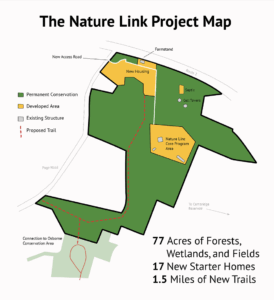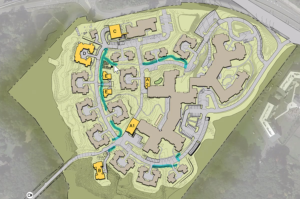Lincoln could see 20 new homes near Route 2 along with dozens of acres of newly town-owned woods and wetlands if residents vote yes at a Special Town Meeting on June 25.
Seventeen of the 20 homes will be tightly clustered 1,850-square-foot “starter homes” on 14 acres of Page Road land currently owned by the Panetta family. The town proposes to buy a total of 77 acres from the Panettas and Farrington Memorial (which operates the nonprofit Farrington Nature Linc) for $6.4 million. Funds for the purchase would come from developer Consigli ($3.3 million), which built Oriole Landing, as well as $800,000 from the City of Cambridge, $950,000 from the Lincoln’s Community Preservation Act fund, and $1.35 million in private donations.
Farrington Memorial will retain ownership of some of its land within its parcel that will be accessed (as will the new houses) from a roadway coming off Page Road, and Farrington Nature Linc will continue to operate as it now does (see the Lincoln Squirrel, April 17, 2015).
To make it all happen, voters must two zoning measures by a two-thirds margin — a change to the existing North Lincoln Overlay District for the proposed housing and another to preserve the existing Gerard’s Farm Stand on Route 2 — plus the CPA funding for the conservation component of the project that would protect the land from development and eventually add 1.5 miles of new trails connecting to the Osborn Conservation area to the south.
The deal won’t go through unless the RLF can raise $1.35 million in donations by June 25. RLF Executive Director Geoff McGean acknowledged the tight timeline for fundraising and voter approval. “It’s a very complicated project with a lot of moving parts that somehow all come together at this brief moment in time, unfortunately,” he said.
The fundraising effort will include appeals to foundations, friends of conservation, and a townwide mailing. “Most of the time it’s individual Lincoln residents that step up, and we’re hopeful that residents will think this is a good project worth supporting,” McGean said.
The housing plan is modeled on the state’s nascent 40Y program, which offers a zoning tool for towns to approve “starter homes” of up to 1,850 square feet in districts that allow at least four starter homes per acre. However, though the law has been passed, the state has not yet released specific guidelines for towns and developers, so there will be no opportunity for state grants or other involvement, McGean said.
The RLF presented the proposal to the Select Board on April 14 and will make an informal presentation to the Planning Board on Tuesday, April 29.
The plan is similar in some respects to the town’s 2016 purchase of the Wang property on Bedford Road. That deal paved the way for a new home for the Birches School, a new town playing field, and several acres of conservation land.









